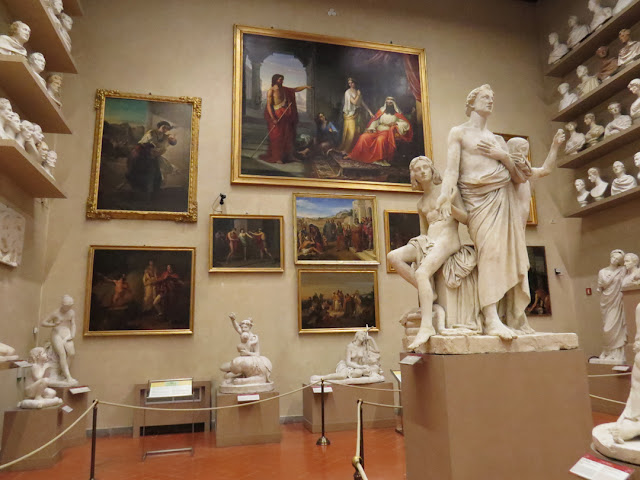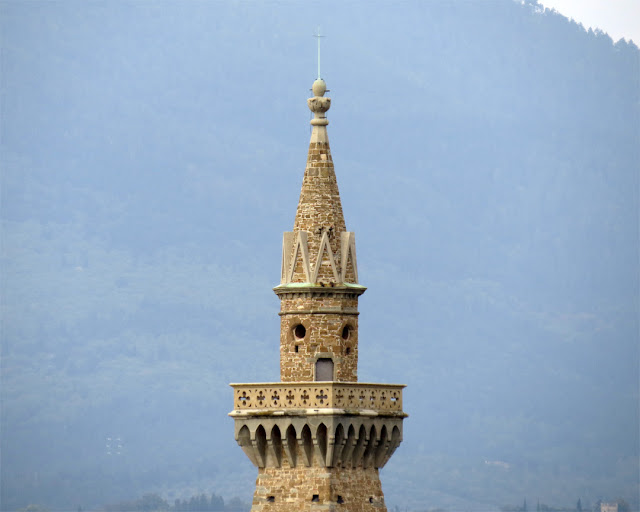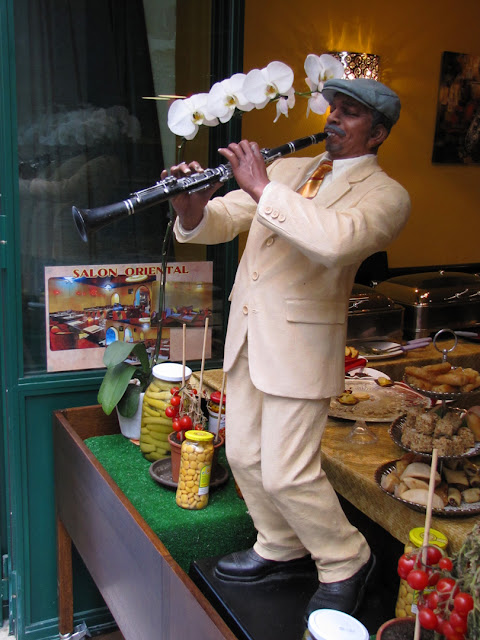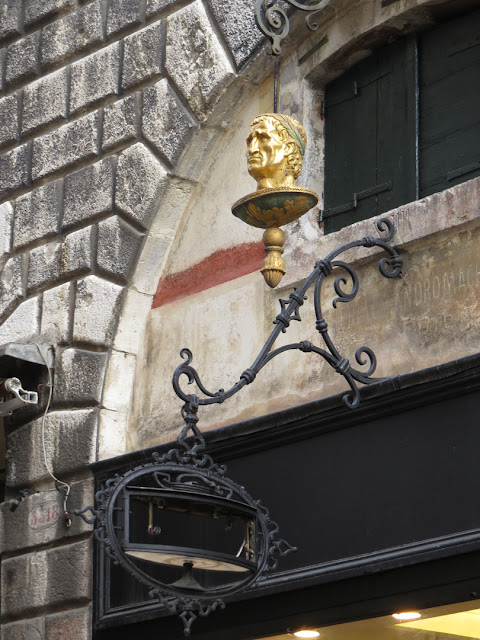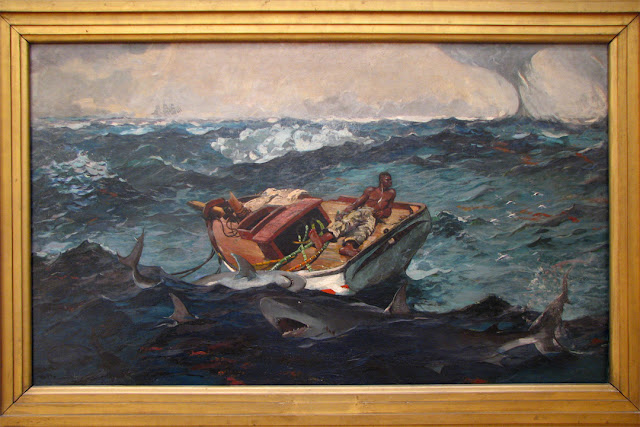Friday, February 28, 2014
Piazza dei Maccheroni
Street sign
Piazza dei Maccheroni (Macaroni Square)
Florence, November 2013
“According to a widespread misconception, macaroni was brought to Italy by Marco Polo, returning to Venice from China in 1292. This hypothesis has long been disproved, since it seems that macaroni was already used in Italy at least a century before, like pasta in general; Moroccan geographer Muhammad al-Idrisi, who lived in Sicily, documented macaroni in Sicily and in particular in Trabia.” (Macaroni, Wikipedia)
Thursday, February 27, 2014
Water Bikes
Water bikes
Ponte Lungo canal, Murano
Venice, September 2013
“The Shuttle-Bike kit adapts to almost any bike with round frame tubes with a set of universal clamps. Permanently fastened on the frame, they do not hinder the use of the mountain-bike on the road. The permanent clamp accessories are designed to lock onto the Shuttle-Bike frame without using any tools--the whole kit snaps together, tightens and inflates by hand and pedal-power in about 10 minutes.” (Shuttle-Bike - convert a bike to a pedal-power boat, Gizmag)
See also: Paddling the Canals
Wednesday, February 26, 2014
Port Jersey
Global Terminal, Bayonne (New Jersey), Port Jersey
Port of New York and New Jersey
Upper New York Bay
New York, September 2008
“Vessel access to Global terminal is through a straight 6,000 foot long channel, 750 feet wide with a depth of 45 feet at mean Low Water (MLW) with no air draft restrictions. By the end of 2011, the USACE plans to dredge the channel depth to 50 feet. This channel is linked to the Ambrose Anchorage Channels. At the west end of the access channel is a 1,200 foot turning basin. The number of berths total 2 spread over a length of 1800 feet, equipped with 6 Post Panamax quay cranes. Construction is underway to extend the berth to 2700 feet by 2013.” (Terminal Overview, Global Terminal & Container Services)
Tuesday, February 25, 2014
André Le Nôtre
Bust of André Le Nôtre by Antoine Coysevox
Jardin des Tuileries (Tuileries Garden)
Quartier Saint-Germain-l'Auxerrois, 1st arrondissement
Paris, July 2012
“The monument lists André Le Nôtre greatest works. He Transformed the gardens of the Tuileries Palace, first laid out in the mid 176th century, into a grand formal garden that stretches between the Louvre and the Place de la Concorde, opened to the public in 1667. Since the 19th century, it has been a primary place for Parisians to gather to relax and celebrate. I don't know when this monument was installed near the entrance by the Place de la Concorde, but it appears to be fairly modern. The bust was clearly made after an earlier sculpted commemorative portrait of Le Nôtre by Antoine Coysevox.” (André Le Nôtre Monument in Paris, Public Art and Memory)
Monday, February 24, 2014
Salone dell'Ottocento
Gypsoteque dedicated to Lorenzo Bartolini
Salone dell'Ottocento (19th Century Hall)
Galleria dell'Accademia
Via Ricasoli
Florence, October 2013
“At the end of the left wing of the tribune of Michelangelo's David is the Gipsoteca dedicated to Lorenzo Bartolini (1777- 1850), in the Salone dell'Ottocento (19th century hall). The galleria dei gessi was opened to the public in 1985. Revealing the portraitist Bartolini's great skill are about 300 busts representing the Florentine upper middle class. The mythological theme is richly and beautifully illustrated: Voto dell'Innocenza (The Vote of Innocence), Venus, and others.” (The Accademia Gallery, Weekend in Italy)
Sunday, February 23, 2014
Model at Work
Model at work
Campo Santo Stefano, San Marco
Venice, October 2013
See also: Model and Photographers - Photographers
Saturday, February 22, 2014
Athena Leads the Young Warrior
“Der Jüngling wird von Athena in neuen Kampf geführt”
(Athena leads the young warrior into the fight) by Albert Wolff, 1853
Schloßbrücke (Palace Bridge)
Berlin, September 2011
“Stone bridge built 1821-24 after a design of the architect Karl Friedrich Schinkel. The main elements of the bridge's decorations are the eight more-than-life-size sculpture groups on high marble pedestals over the stone bridge piers. The groups show scens from Greek mythology related to warfare. These Carrara marble statues were sculpted between 1847 and 1857 by various students of Christian Daniel Rauch. The red granite pedestals rest on pedestals, they are provided with circular medallions, work of the sculptor Friedrich Wilhelm Wolff, each motif is the image of an eagle with symbolic additions. The original medallions are lost and reconstructed in 1989.” (Statues on the Palace Bridge, Statues - Hither & Thither)
See also: The Wounded Warrior - Athena Arms the Warrior - Nike Instructs the Boy - Athena Protects the Young Hero
Friday, February 21, 2014
The Exercise Tower
“The Exercise Tower” by Wang Du, 2007
État-Major de la Brigade de Sapeurs-pompiers de Paris
Place Jules Renard
Quartier des Ternes, 17th arrondissement
Paris, July 2012
“It was made by Wang Du, a Chinese artist who has been living in France for 20 years now and who was ordered a monument dedicated to the Paris firemen, by the Paris town hall. It's called the Exercise Tower, and it's located right in front of one of the largest fire stations in Paris, at Place Jules Renard. It weighs 7 tons, it's 11 meters high and it's made of polished iron, just like the firemen helmets.” (The exercise tower, Paris Daily Photo)
Thursday, February 20, 2014
Santa Croce Bell Tower
Detail of the bell tower seen from Piazzale Michelangelo
Basilica di Santa Croce (Basilica of the Holy Cross)
Piazza di Santa Croce
Florence, October 2013
“A new plan to complete the piece of architecture was presented in 1842 by the architect Gaetano Baccani: the project was approved and the bell tower, this time built next to the sacristy, was finished in 1847. The material used was the typical Florentine limestone masonry having a yellowish warm colour, already used to build other parts of the church. The structure appeared lighter thanks to the presence of single-lancet windows, frames and a cusp lantern.” (The bell tower, Opera di Santa Croce)
See also: Basilica di Santa Croce
Wednesday, February 19, 2014
Clock of the Doge's Palace
Clock by Johan Slim, 1614
Courtyard of the Doge's Palace
Venice, September 2013
“The restoration operations currently being undertaken by Piaget have uncovered the following inscription engraved on one of the bases of the mechanism : ‘Johan Slim – July 1614 – Aug.’. This is the name of the clocwmaker (probably a German) who built it. The mechanism now being renovated is thus the original one corresponding to the construction period of the façade.
But the technical characteristics of this mechanism featured shapes and technical solutions reflecting the work of Bartolomeo Ferraccina (the watchmaker behind the mechanism of the clock in the Torre dell’Orologio): this would of course appear to imply that the latter may have been partially modified half way through the 18th century, while retaining the spaces and passages of the original version, and especially respecting the strange cell suspended behind the dial – one of the main reasons behind the fascination still exercised by the courtyard clock.” (Restoration of the clock in the courtyard of the Doge's Palace, The Watch Quote)
Tuesday, February 18, 2014
Cabmen's Shelter
Cabmen's Shelter
Thurloe Place, South Kensington
London, October 2009
“These shelters were small green huts, which were not allowed to be larger than a horse and cart, as they stood on the public highway. Between 1875 and 1914, 61 of these buildings were built around London. Most were staffed by an attendant who sold food and (non-alcoholic) drink to the cabbies and were provided with a kitchen in which the attendant could cook this food and also food provided by the cabbies themselves. The attendant was not generally paid, but was expected to make an income from these sales. The shelters were also provided with seats and tables and books and newspapers, most of them donated by the publishers or other benefactors. Most could accommodate ten to thirteen men. Gambling, drinking and swearing were strictly forbidden.” (Cabmen's Shelter Fund, Wikipedia)
Monday, February 17, 2014
L'Arganier
Restaurant “L'Arganier”
Rue Sainte-Croix-de-la-Bretonnerie, Le Marais
Quartier Saint-Merri, 4th arrondissement
Paris, July 2012
Sunday, February 16, 2014
The Fisher Boy
“Il Pescatore” (The Fisher Boy) by Vincenzo Gemito, 1874-1876
Museo nazionale del Bargello (Bargello National Museum)
Via del Proconsolo
Florence, October 2013
“Maybe you will feel that way about my favorite here Il Pescatore (The Fisher Boy) by Vincenzo Gemito from 1874-1876. But I love the natural gesture of this bronze figure sculpture. I like that the patina is not what my foundry calls ‘cowboy brown’ or worse – shiny. I love the way the boy’s toes are gripping the mound he is squatting on. I can remember this feeling of slowly sliding down the side of the muddy river bank, while trying not to.” (Gemito Sculpture Bargello Museum, Fine Art by Kelly Borsheim)
Saturday, February 15, 2014
Cortile Piccolo
Cortile Piccolo (Small Courtyard)
Ca' Foscari University
Venice, October 2013
“The two internal courtyards in the Foscari-Giustinian complex are interconnected by a ‘sotoportego’ (portico). The surface area of the Cortile Grande is 900 m• and it is the largest private courtyard in Venice, after that of the Palazzo Ducale. The recently restored, magnificent portal, bearing the Foscari family coat-of-arms, unfolds to reveal the grand court. The charming Cortile Piccolo, brick-paved in fish bone style, contains one of the best-preserved well curbs in Venice. It is embellished with sculpture elements such as acanthus and flowers. The chromatic contrast between brickwork and stone is repeated in the elegant stairway with steps in stone that lead up to the ‘piano nobile’ second floor of Ca' Giustinian, now the President’s offices. In the summer season, Ca’ Foscari courtyards are used for a variety of cultural and musical events, initiatives related to research and innovation, social events, exhibitions and meetings of an international level. Given the context of the two buildings, it is a natural place to hold receptions, cultural events, shows and other kinds of initiatives.” (Cortile Grande e Cortile Piccolo Ca' Foscari, Ca'Foscari)
Friday, February 14, 2014
Thursday, February 13, 2014
La Foule
“La Foule” (The Crowd) by Raymond Mason, 1963-7
Jardin des Tuileries (Tuileries Garden)
Quartier Saint-Germain-l'Auxerrois, 1st arrondissement
Paris, July 2012
“Once Mason was drawing his own sculpture, The Crowd, in the Tuileries Gardens. A stranger watched him for a long time in silence and eventually remarked: ‘You draw really well. But why are you drawing that shit?’” (Raymond Mason obituary, The Telegraph)
Wednesday, February 12, 2014
Fontana del Buontalenti
Fountain by Bernardo Buontalenti, (end of 16th Century)
Via dello Sprone / Borgo San Jacopo
Florence, November 2013
“This masterpiece by Buontalenti (end of 16th Century) with a striking grotesque mask, is probably the most famous fountain of Oltrarno; it was made after the fountain by Chiarissimo Fancelli located at the corner of the old Corn Market, in Via de' Neri, near Piazza della Signoria.” (Oltrarno's Fountains, Firenze-Oltrarno.net)
Tuesday, February 11, 2014
Ponte Piscina San Samuele
Ponte Piscina San Samuele (Saint Samuel Pool Bridge)
Rio del Pestrin, San Marco
Seen from the Ponte del Pestrin
Venice, September 2013
Monday, February 10, 2014
Nike Instructs the Boy
“Nike lehrt den Knaben Heldensagen” (Nike instructs the boy in heroic history) by Emil Wolff, 1847
Schloßbrücke (Palace Bridge)
Berlin, September 2011
“Stone bridge built 1821-24 after a design of the architect Karl Friedrich Schinkel. The main elements of the bridge's decorations are the eight more-than-life-size sculpture groups on high marble pedestals over the stone bridge piers. The groups show scens from Greek mythology related to warfare. These Carrara marble statues were sculpted between 1847 and 1857 by various students of Christian Daniel Rauch. The red granite pedestals rest on pedestals, they are provided with circular medallions, work of the sculptor Friedrich Wilhelm Wolff, each motif is the image of an eagle with symbolic additions. The original medallions are lost and reconstructed in 1989.” (Statues on the Palace Bridge, Statues - Hither & Thither)
See also: The Wounded Warrior - Athena Arms the Warrior - Athena Leads the Young Warrior - Athena Protects the Young Hero
Sunday, February 9, 2014
Charles Perrault
Monument to Charles Perrault by Gabriel Pech, 1908
Jardin des Tuileries (Tuileries Garden)
Quartier Saint-Germain-l'Auxerrois, 1st arrondissement
Paris, July 2012
Saturday, February 8, 2014
Friday, February 7, 2014
La Testa d'Oro
Old sign of the former “La Testa d'Oro” (The Golden Head) apothecary
Salita Pio X, San Marco
Venice, September 2013
Thursday, February 6, 2014
Wednesday, February 5, 2014
Rue Benjamin Godard
Rue Benjamin Godard seen from avenue Victor Hugo
Quartier de la Porte-Dauphine, 16th arrondissement
Paris, July 2012
Tuesday, February 4, 2014
St. Paul's Cannon
Cannone di San Paolo (St. Paul's cannon) by Cosimo Cenni, 1638
Museo Nazionale del Bargello (Bargello National Museum)
Via del Proconsolo
Florence, October 2013
Monday, February 3, 2014
Loggia Amulea
Loggia Amulea
Prato della Valle
Padua, September 2013
“La Loggia Amulea is a neo-Gothic building located in Prato della Valle, the majestic Piazza of Padova. The palace was the home of the fire brigade of Padua from 1906 to 1989, and currently houses some municipal offices. The front of the building is characterised by an elegant porch. In the great room adjoining the balcony are celebrated civil marriages.” (La Loggia Amulea, Daniel Stefan Gandolfo)
Sunday, February 2, 2014
The Gulf Stream
“The Gulf Stream” by Winslow Homer, 1899
Metropolitan Museum of Art
Fifth Avenue
New York, September 2007
“‘The Gulf Stream’ was based upon studies made during Homer's two winter trips to the Bahamas in 1884–85 and 1898–99. First exhibited at the Pennsylvania Academy of the Fine Arts in Philadelphia in 1900, the picture was subsequently reworked and "improved" by the artist. Early photographs show changes to the sea and to the back of the ship, making the composition more dramatic and vivid. The painting was shown in this state at the Carnegie Institute in Pittsburgh in 1900–01, and then at M. Knoedler and Co. in New York, where the artist placed on the picture the record-asking price of $4,000. There were problems selling the work because of either its high price or its unpleasant subject matter. Homer may have reworked the painting again in the face of this criticism in order to add the rigger on the horizon that signals hope and rescue from the perils of the sea.” (The Gulf Stream, The Metropolitan Museum of Art)
Saturday, February 1, 2014
La Grisette de 1830
“La Grisette de 1830” by Jean-Bernard Descomps, 1909
Square Jules-Ferry
Quartier de la Folie-Méricourt, 11th arrondissement
Paris, July 2012
“Two female myths grew out of this period – the Grisette and the Lorette. The Grisette here in statue form, (made by the sculptor Jean Descomps in 1909) is simply a representation of a certain kind of female city inhabitant, typically a young factory worker or itinerant street vendor. The chosen position here was not an accidental one as many such girls would have lived in this area, selling food or flowers in the surrounding streets or working in one the factories along the canal.” (Grisettes et Lorettes, Invisible Paris)
Subscribe to:
Posts (Atom)





